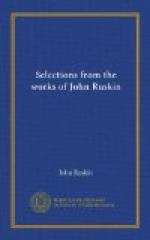But lately this established teaching, never very intelligible, has been gravely called in question. The advocates and self-supposed practisers of “High Art” are beginning to be looked upon with doubt, and their peculiar phraseology to be treated with even a certain degree of ridicule. And other forms of Art are partly developed among us, which do not pretend to be high, but rather to be strong, healthy, and humble. This matter of “highness” in Art, therefore, deserves our most careful consideration. Has it been, or is it, a true highness, a true princeliness, or only a show of it, consisting in courtly manners and robes of state? Is it rocky height or cloudy height, adamant or vapour, on which the sun of praise so long has risen and set? It will be well at once to consider this.
And first, let us get, as quickly as may be, at the exact meaning with which the advocates of “High Art” use that somewhat obscure and figurative term.
I do not know that the principles in question are anywhere more distinctly expressed than in two papers in the Idler, written by Sir Joshua Reynolds, of course under the immediate sanction of Johnson; and which may thus be considered as the utterance of the views then held upon the subject by the artists of chief skill, and critics of most sense, arranged in a form so brief and clear as to admit of their being brought before the public for a morning’s entertainment. I cannot, therefore, it seems to me, do better than quote these two letters, or at least the important parts of them, examining the exact meaning of each passage as it occurs. There are, in all, in the Idler three letters on painting, Nos. 76, 79, and 82; of these, the first is directed only against the impertinences of pretended connoisseurs, and is as notable for its faithfulness as for its wit in the description of the several modes of criticism in an artificial and ignorant state of society: it is only, therefore, in the two last papers that we find the expression of the doctrines which it is our business to examine.
No. 79 (Saturday, October 20, 1759) begins, after a short preamble, with the following passage:—
“Amongst the Painters, and the writers on Painting, there is one maxim universally admitted and continually inculcated. Imitate nature is the invariable rule; but I know none who have explained in what manner this rule is to be understood; the consequence of which is, that everyone takes it in the most obvious sense—that objects are represented naturally, when they have such relief that they seem real. It may appear strange, perhaps, to hear this sense of the rule disputed; but it must be considered, that, if the excellency of a Painter consisted only in this kind of imitation, Painting must lose its rank, and be no longer considered as a liberal art, and sister to Poetry: this imitation being merely mechanical, in which the slowest intellect is always sure to succeed best; for the Painter of genius cannot stoop to drudgery, in which the understanding has no part; and what pretence has the Art to claim kindred with Poetry but by its power over the imagination? To this power the Painter of genius directs him; in this sense he studies Nature, and often arrives at his end, even by being unnatural in the confined sense of the word.




